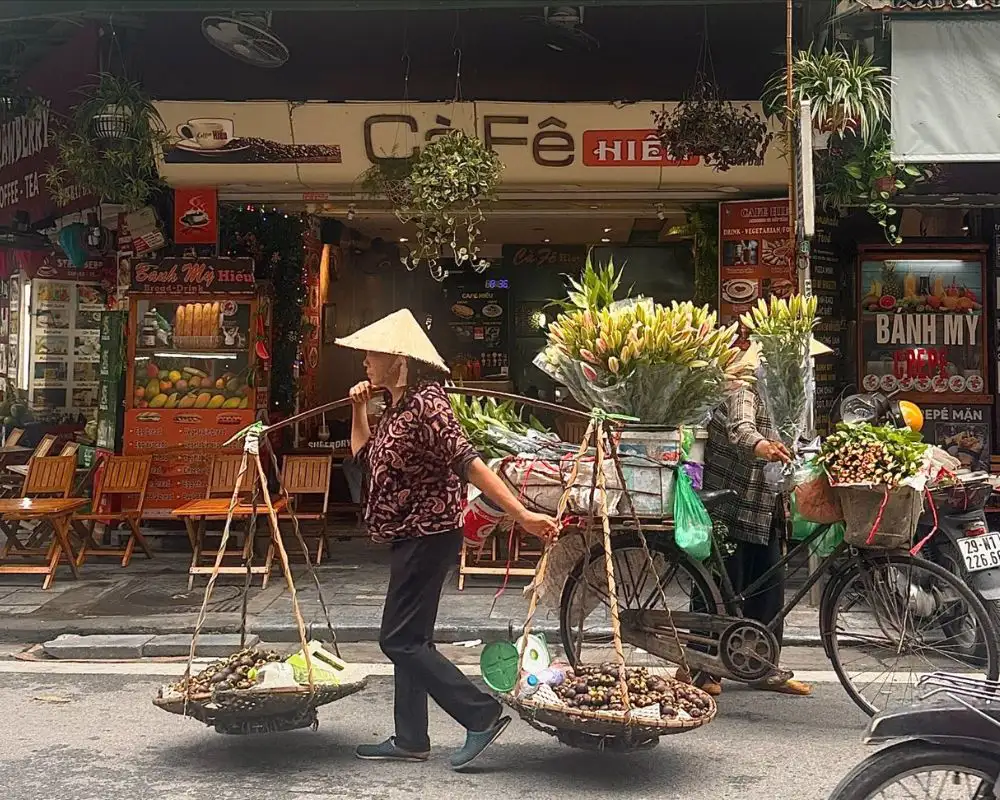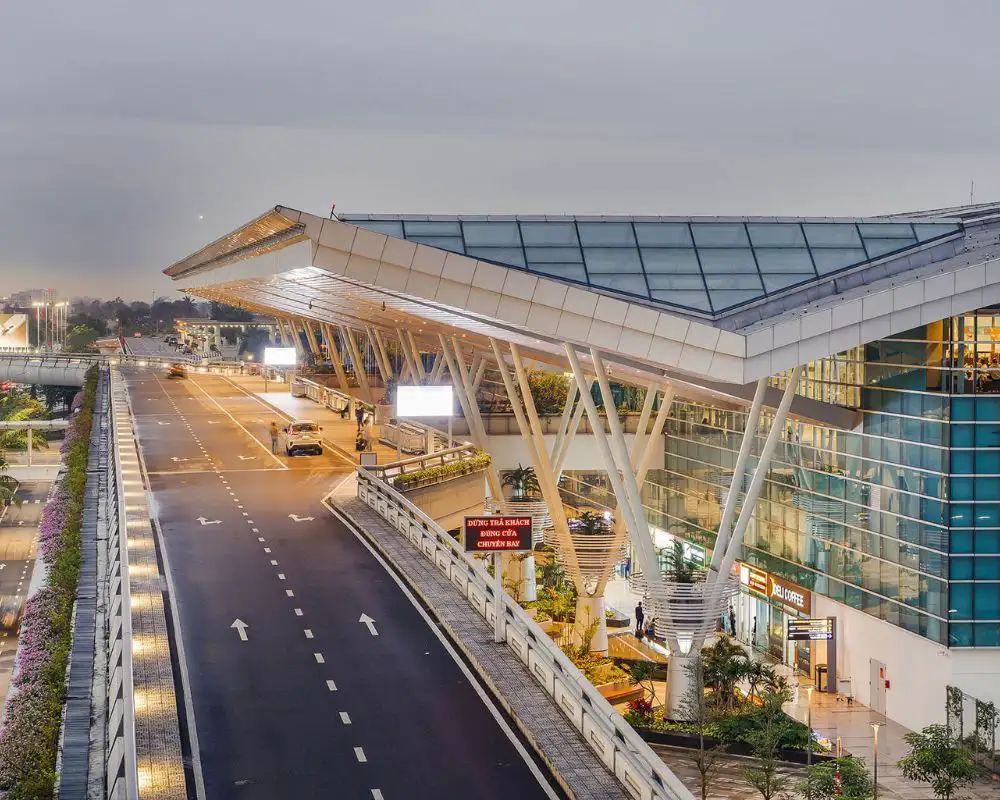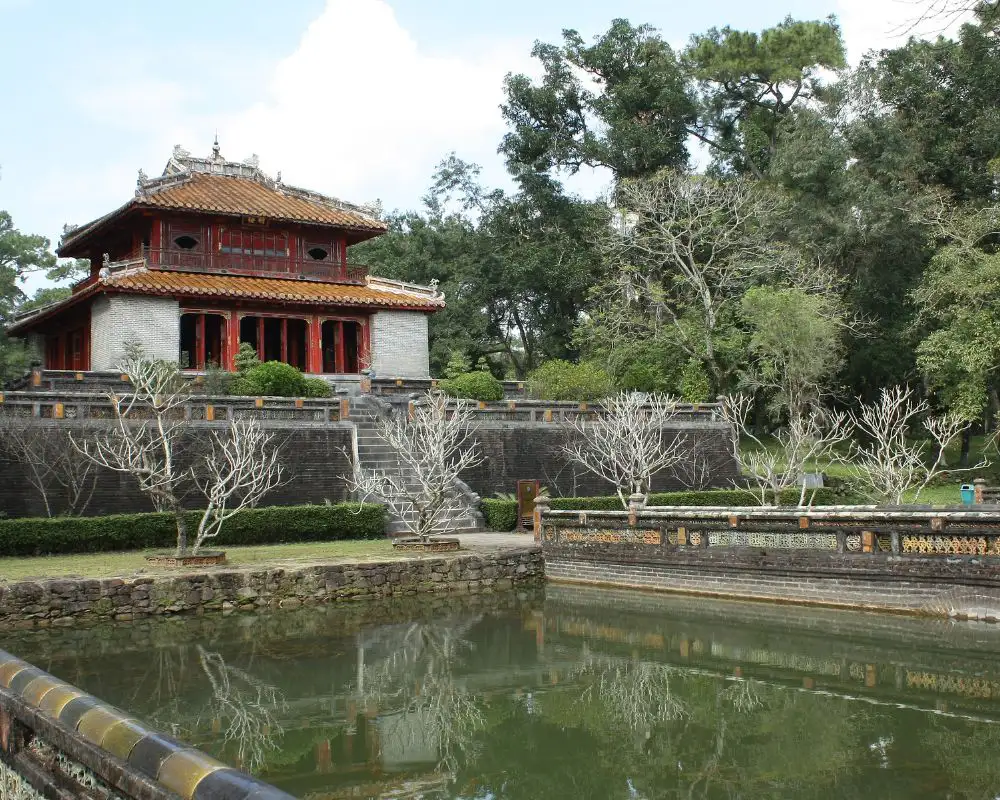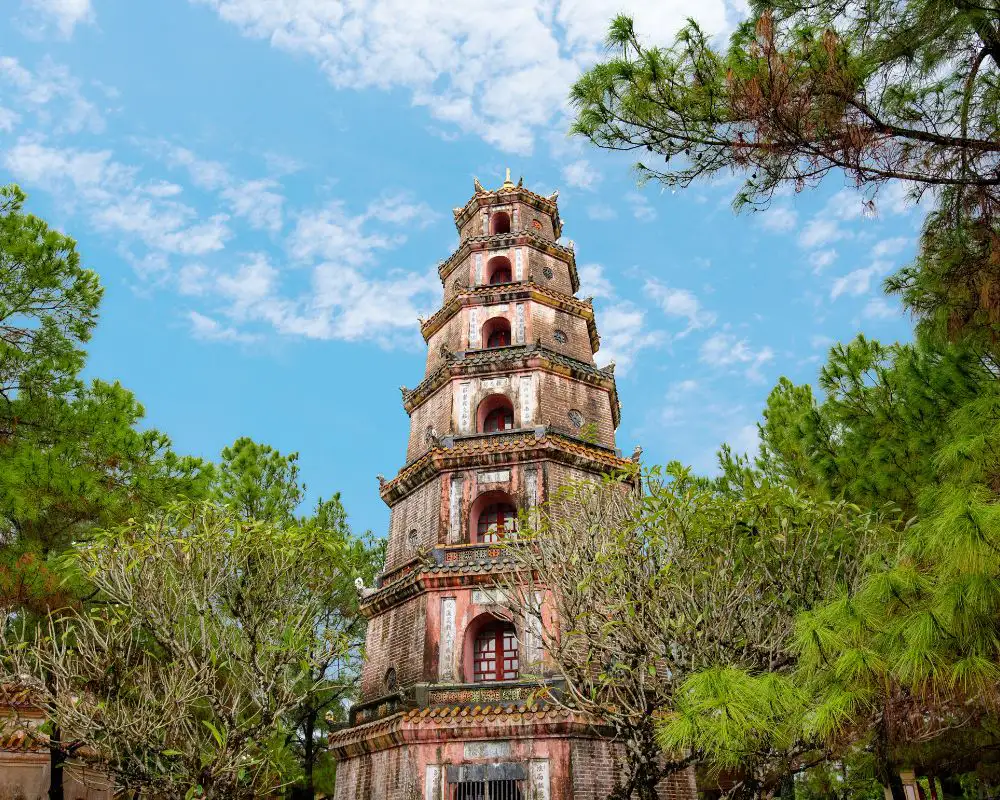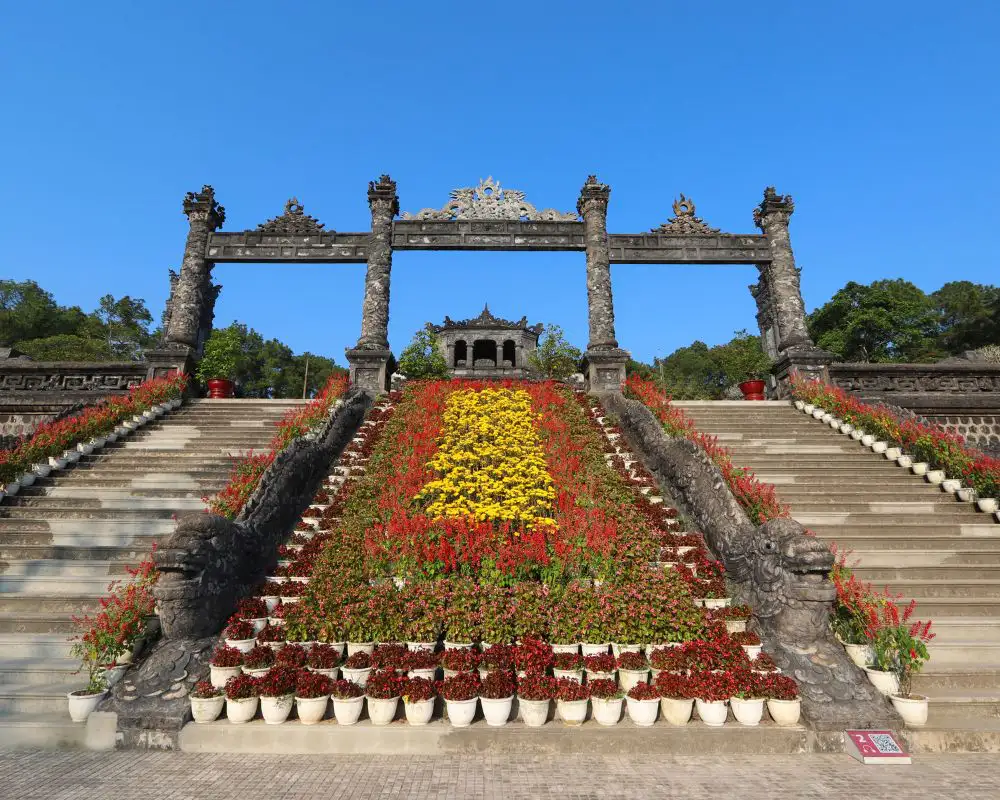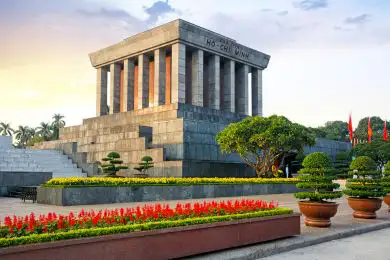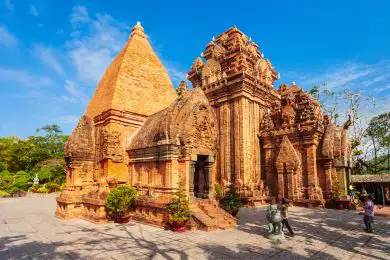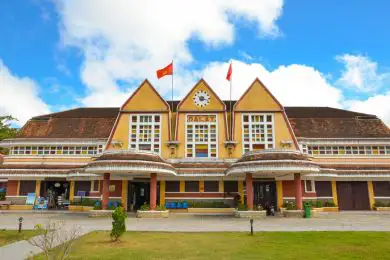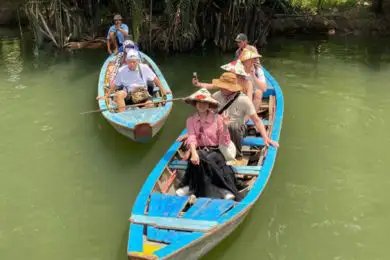Vietnam Trails Travels is a local agency based in Ho Chi Minh City, specializing in customized tours in Ho Chi Minh City and Hanoi. With our deep knowledge and passion for local culture and cuisine, we offer you more than just aHo Chi Minh city tour, we provide an unforgettable culinary experience. If you’re planning a trip to Ho Chi Minh City and looking to enjoy some of the best street food, we are here to share our top picks with you. Here are the Top 20+ Best Vietnamese street food in Ho Chi Minh City that will make your visit even more memorable.
1. Hủ Tiếu Nam Vang (Southern rice noodle soup)
Hu Tieu Nam Vang must-try dishes in Ho Chi Minh City. It is a dish originating from Phnom Penh, Cambodia. The Chinese community in Nam Vang reprocessed and brought this dish back to Vietnam. Later, Southern rice noodle soup was added with richer spices to match the culinary culture of the Vietnamese people. It became a specialty of Saigon and is famous street food in three regions.
You can eat Hu Tieu Nam Vang in two ways: dry and water. The main ingredients will include noodle soup, pork liver, shrimp, minced meat, squid or crab, raw vegetables such as cilantro, coriander, bean sprouts, salad and delicious broth. Tofu or spring rolls can be added to taste.
The broth is cooked from stewed bones or you can use existing noodle soup. The dish is usually garnished with fried onions and garlic and boiled eggs or scrambled eggs. Nam Vang noodle soup is usually eaten hot and accompanied by spices such as sauteed garlic, pepper, soy sauce, chili and lemon for added flavor.
A bowl of hu tieu is usually pretty reasonably priced at street stalls but can be more expensive if you’re dining at more established restaurants.
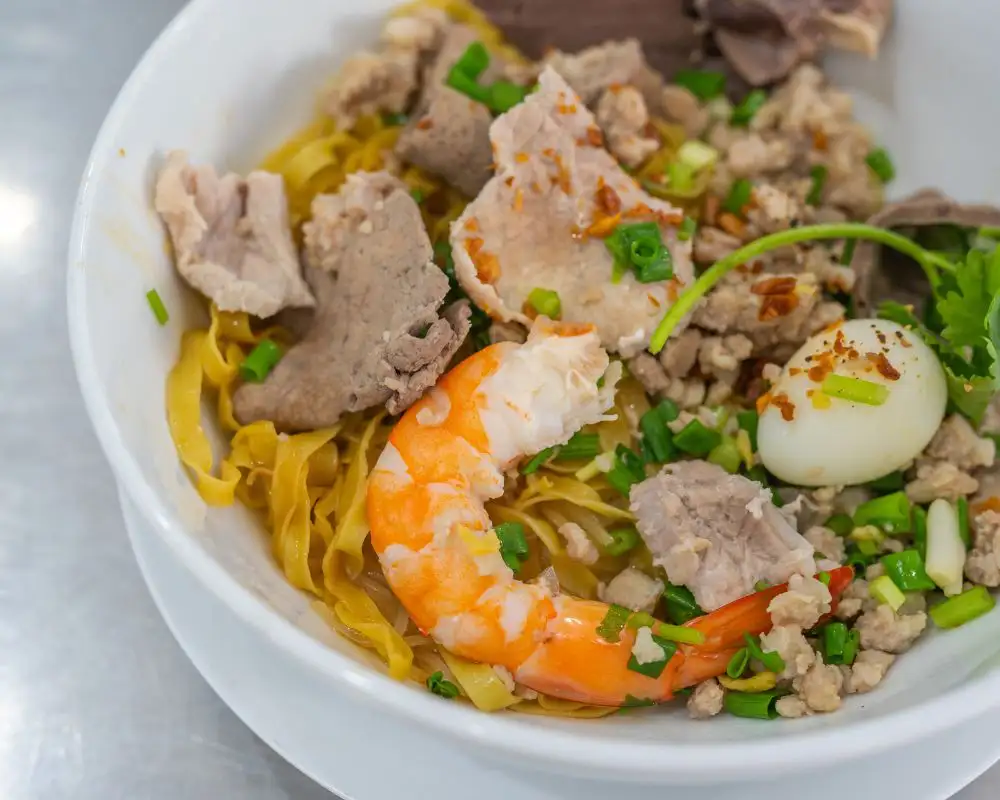
2. Bánh Cuốn (Stuffed pancake)
One of the Top 20+ Best Vietnamese street food in Ho Chi Minh to recommend is Banh Cuon. It is from China, when entering Vietnam, Banh Cuon is processed differently depending on the region.
Typically, the origin of Thanh Tri rolls, from the 18th Hung King period, people gathered in Thanh Tri to reclaim land and was taught farming by An Quoc son of King Hung. The profession of making rolls was also formed from this period.
Through the process of spreading Banh cuon, it has spread throughout the country, not only in the North but also in the Central and Southern regions, there are also famous banh cuon shops such as Banh Cuon Thanh Tri, Banh Cuon Lang Kenh, Banh Uot, Banh Cuon Tay Ho,…
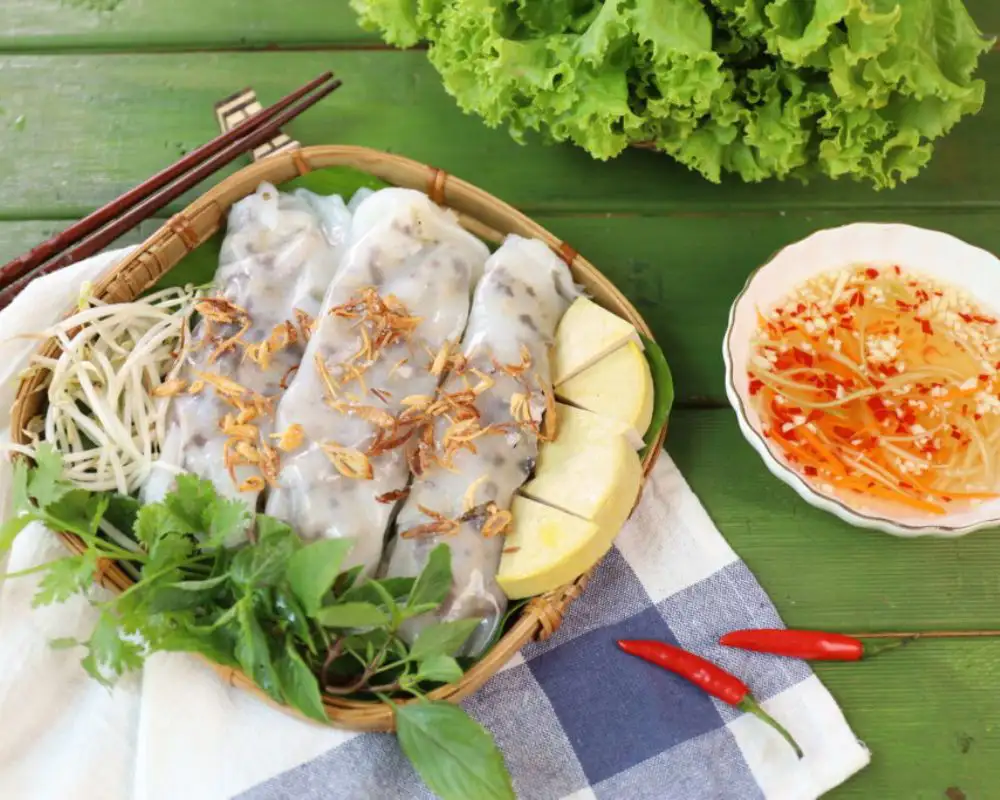
Banh cuon is a type of cake made from rice flour, they are hot coated with some kinds of fillings like: ground meat, wood ear, egg, shrimp, … and then rolled.
A plate of hot and smooth spring rolls is spread on the surface of the cake with a layer of fragrant onion oil served with shredded cucumber, herbs and stimulating sweet and sour fish sauce that makes you feel irresistible.
The way to make rolls is also straightforward but delicate. First, you mix rice flour with water into a thin mixture, then pour it on the glass and cover it thinly.
Place the filling on top of the cake and roll it into a roll shape. Next, steam the cake until cooked. Garnish the rolls with fried onions and raw vegetables, then enjoy with delicious sweet and sour fish sauce.
3. Bánh Hỏi (Fine Rice Vermicelli)
Bánh Hỏi must-eat dishes in Saigon, originated from Dieu Tri, is an indispensable dish every morning of Binh Dinh people. Banh Hoi is made from rice like vermicelli, but the fibers are thinner. Served with banh cuon is heart and sliced pork, next to a cup of hot porridge and slightly sweet chili garlic fish sauce to suit the taste of Vietnam central people.
Making the cake is quite simple, including mixing rice flour with water, steaming the dough until cooked, then cutting it into small pieces. BanhHoi is often enjoyed with grilled meat, pork, onion fat, tofu, spices and raw vegetables.
Read more: Top Vietnam Tourist Attractions 2024
4. Bánh Canh (Vietnamese Thick Noodle Soup)
Banh Canh is top 20 must-try local food in Ho Chi Minh, originated in the Southeast, then popularized throughout Vietnam. The broth from banh chung is cooked from pork, chicken or seafood bones until it has a rich flavor. Meanwhile, make pancakes from rice flour or starch. When the broth has boiled, add in the meat and seafood.
Finally, put the banh chung into the pot, wait for the soup to cook and attract the flavor of the broth and meats. Cake soup is often decorated with raw vegetables such as onions, cilantro, coriander, bean sprouts to add flavor and freshness to the dish. This is a dish that you must try when you visit HCMC.
Some typical thick noodle soups in Vietnam include banh canh bot gao, banh canh bot loc, banh canh bot xat, banh canh bot mi,…
Some famous thick noodle soups: Bánh canh Trảng Bàng, Bánh canh chả cá Phan Rang, Bánh canh cua, bánh canh tôm, Bánh canh cá lóc, Bánh canh mặn nước cốt dừa, Bánh canh khô xứ Huế.
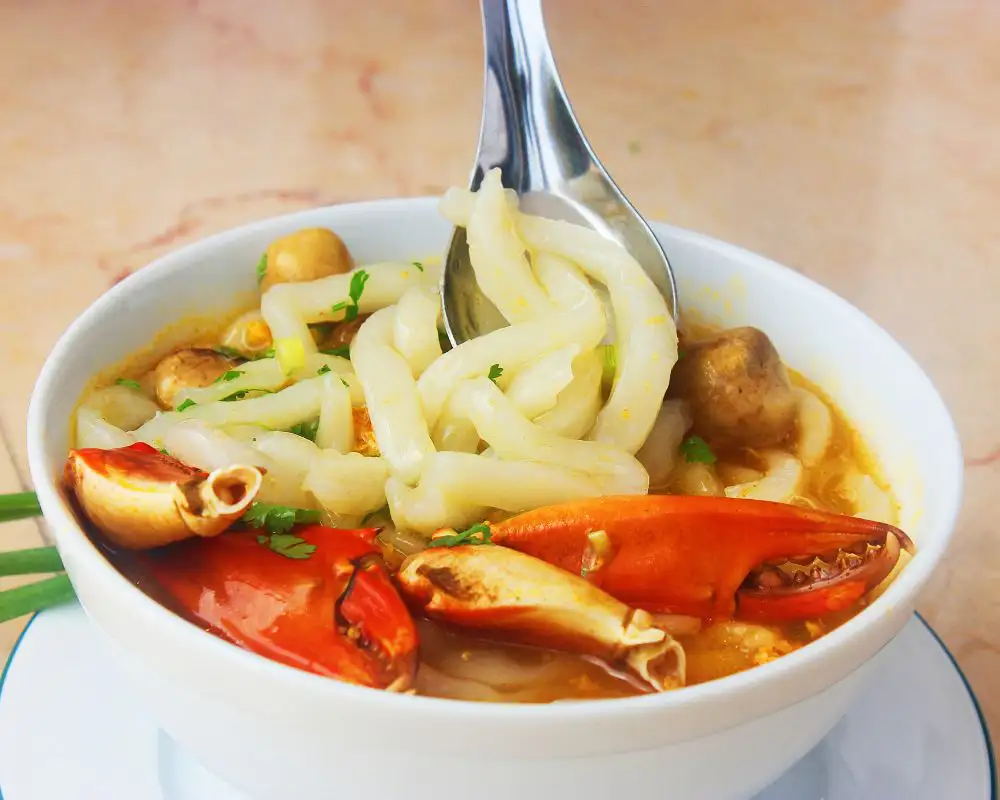
5. Cháo Lòng (Pork Offal Congee)
Cháo Lòng is top 20 best Vietnamese street food in Ho Chi Minh with a strange taste. It is relatively common in Vietnamese cuisine, and it is widely sold in stores nationwide.
Usually, Chao Kong is eaten with blood pudding and pig intestines and often combined with wine. Especially in the rainy season, it’s cold; if you enjoy a bowl of warm porridge, it will help keep your body warm.
Cook broth from pork or chicken bones until rich in flavor. Then, blanch the pork belly with boiling water and pour cold water to keep it crispy. Next, cook the intestines in the broth until soft and absorbed.
Finally, mix the heart with cooked rice to make a smooth porridge and enjoy with spices and raw vegetables for extra flavor.
6. Cơm Tấm (Broken Rice)
Cơm Tấm must-try Vietnamese dishes. When we hear about Cơm Tấm, we know that the small grain of rice is broken, so it is only used by poor farmers to create the Mekong Delta. The reason is that in the years of famine, many people did not have enough good rice to sell, so they saved money by using broken rice.
From the first half of the twentieth century, when Vietnam entered the process of urbanization, broken rice became popular in most of the southern provinces, especially Saigon.
When it has become a major tourist destination of the country attracting many international tourists, the vendors have adjusted broken rice to suit the taste and style of the diners. Broken rice began to be served with a plate, using a spoon and a fork instead of bowls and chopsticks like the original.
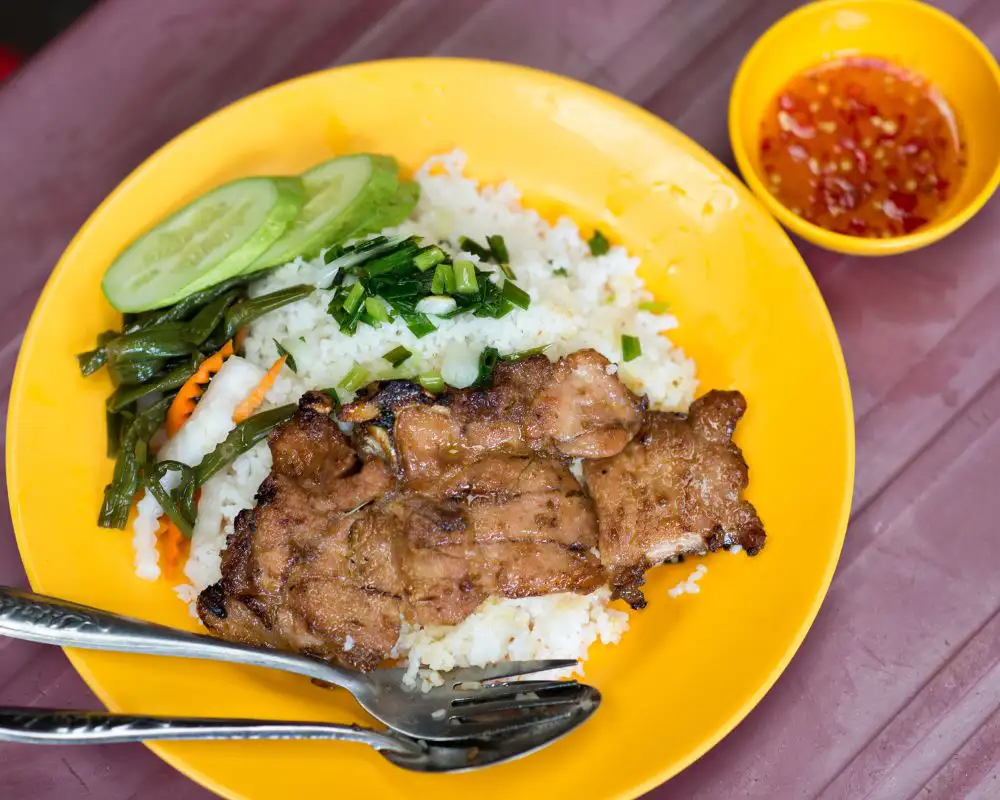
A traditional plate of broken rice includes: 1 part of rice, 1 part of grilled ribs, 1 part of pork skin, 1 part of egg rolls and dipping sauce.
Broken rice is usually cooked by steaming, not using a pot, this helps the rice grains to cook evenly. The meat will be marinated with spices and then grilled. The most important part of the plate of broken rice is fish sauce, broken rice must be eaten with fish sauce over rice or meat is the right plate of broken rice.
Served with broken rice, the most traditional and delicious dish must be “ribs – skins – rolls”, including grilled ribs, mixed pork rolls, fried egg rolls and sour food, greasy onion sauce and a cup of sweet and sour fish sauce. rich to make the dish more round.
7. Phở
Pho is the next locak food in Top 20+ Best Vietnamese street food in Ho Chi Minh. Most Vietnamese historians agree that Pho started to appear in the late 19th and early 20th centuries in northern Vietnam during the French colonial period, but the origin of Pho remains a mystery.
Some people believe Pho is a variant of the French beef and vegetable stew-au-feu, which is phonetically similar to “Pho”. Others argue that Pho emerged from the Chinese communities settled in northern Vietnam and they sold a dish called “beef noodles”, whose Chinese pronunciation is similar to the “Pho” in Chinese. Vietnamese.
Pho’s main ingredients are Pho noodles, broth, and thinly sliced beef. In addition, there are spices such as soy sauce, pepper, lemon, fish sauce, chili. Pho is usually used as a breakfast dish, or for dinner.
In the southern provinces of Vietnam, Pho is presented with additional ingredients called herbs such as onions, bean sprouts and coriander leaves, in which coriander is the typical leaf of Pho.
The broth is generally made by stewing beef bones, the meat used for Pho is beef or chicken, and spices include cinnamon, anise, ginger, cardamom, cloves, and coriander seeds. “Banh Pho“, traditionally, is made from rice flour, coated in thin sheets and then cut into fibres.
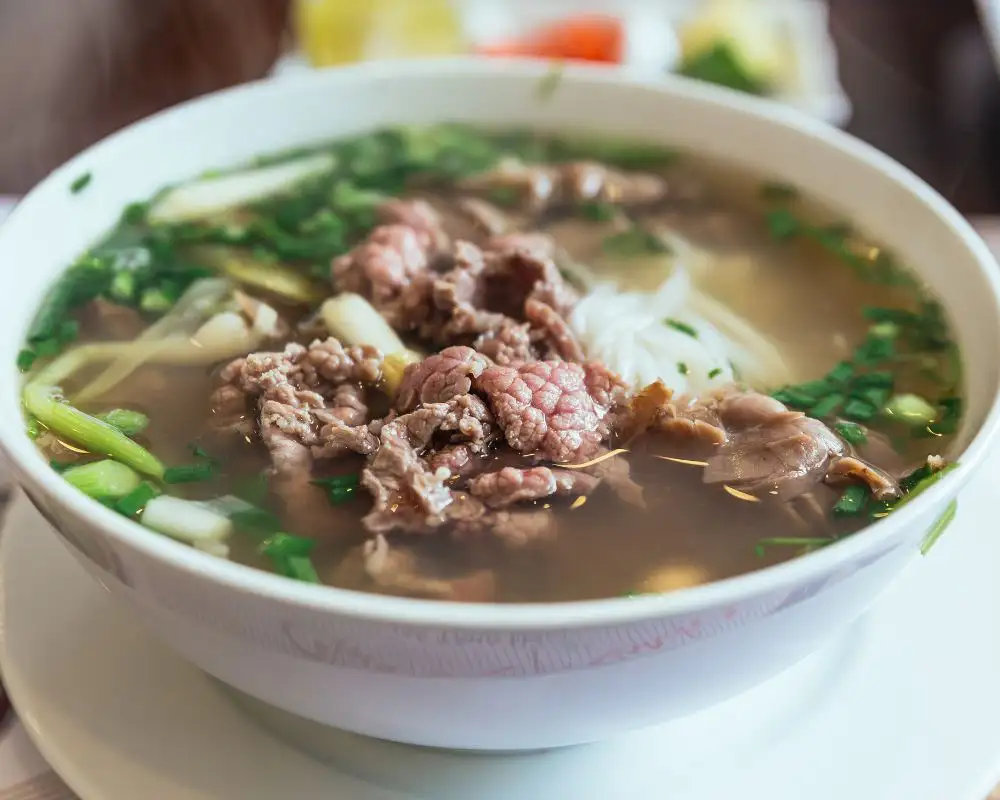
8. Bánh mì
In Vietnam, you can meet any Banh Mi shop on every street, from the National Highway and main road to small alleys. Banh Mi is celebrated as one of the best street food in Ho Chi Minh and the best sandwich in the world.
Banh Mi was gradually introduced to Vietnam, and especially to Saigon since 1859, the French colonial invasion of Gia Dinh citadel brought Banh Mi closer to the people. Initially, this type of food was considered by our people as a side dish, not as a main dish.
Banh Mi is used to eating through the meal, which is not as complete as a regular meal. Gradually, Banh Mi has become one of the features of Vietnamese cuisine.
Types of Banh Mi include Bánh mì thịt, Bánh mì xíu mại, Bánh mì Ốp la, Bánh mì gà, Bánh mì bì, Bánh mì bì, Bánh mì patê, Bánh mì chả cá,… Despite the difference, it is Banh Mi, the taste is always delicious, not fussy, but the delicious taste is made from the simplest ingredients.
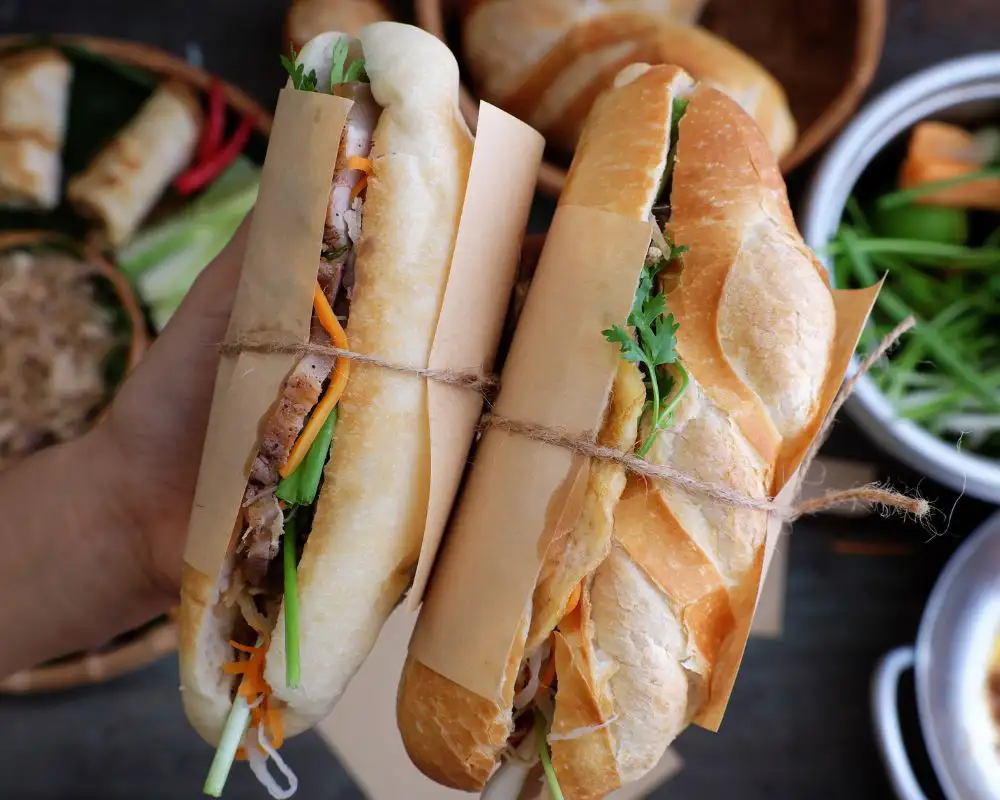
9. Bún Bò Huế (Hue-styled beef noodles)
Bun bo Hue is one of top 20 traditional dishes to try in Vietnam, it is a popular and typical dish of Central Vietnam, especially Hue city. This dish originated from Hue locality around the 19th or early 20th century.
The origin of Bun Bo Hue comes from traditional local dishes, but developed and refined by chefs and Hue people over time. Bun Bo Hue mainly originates from the unique and diverse culinary culture of the Central region, with typical spices and ingredients such as soft vermicelli, beef, pork bones, and pungent flavors.
A bowl of Bun Bo Hue will include noodles, beef, pork blood, crab cakes and broth. The raw material for making vermicelli is rice flour mixed with filtered flour in a standard ratio so that the noodles have moderate toughness.
The beef is the front calf, encrusted with bright red beef or corn, and light yellow beef fat. Eye-catching yellow-orange crab cakes are made from bricks and pureed crab meat with a natural fatty and fleshy taste.
The “soul” of Bun Bo Hue is the broth. The broth is simmered from beef bones, so it has a rich sweet taste. In addition, people also add a little fish sauce and lemongrass to the broth to create an attractive aroma.
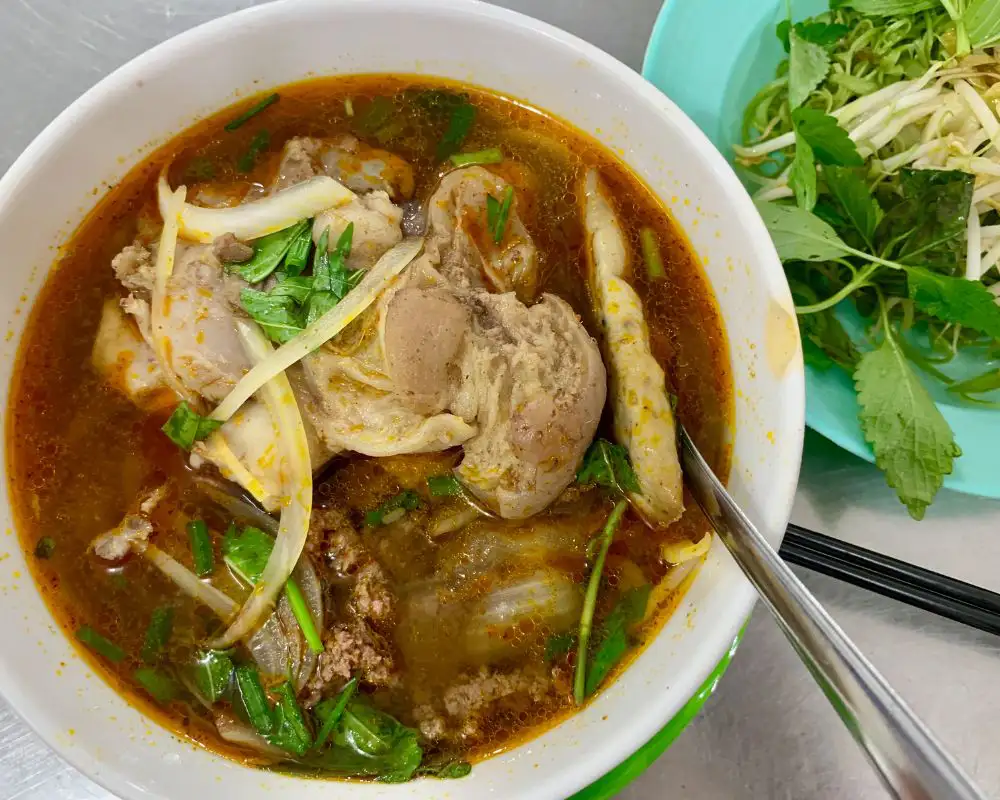
10. Xôi (Vietnamese sticky rice)
If you don’t know what to eat in Saigon, try Xôi immediately. In the past, the ancient Vietnamese did not know plain rice, instead, it was glutinous rice to be processed into Xôi as a daily dish.
Xôi rice has entered the subconscious and culture of Vietnamese people through daily activities and rituals. Xôi is a typical symbol, not only a simple daily dish but also has a solemn meaning in some occasions such as festivals, worshiping ceremonies, longevity celebrations, weddings,…
There are many types of sticky rice, but they can be divided into two main categories: savory and sweet. Savory sticky rice is served with pâté, grilled chicken, char siu, Vietnamese ham, and soy sauce. Sweet sticky rice is more like a dessert, usually with sugar, mashed mung beans, coconut milk, and shredded coconut. If you have a chance, try all kinds of sticky rice.
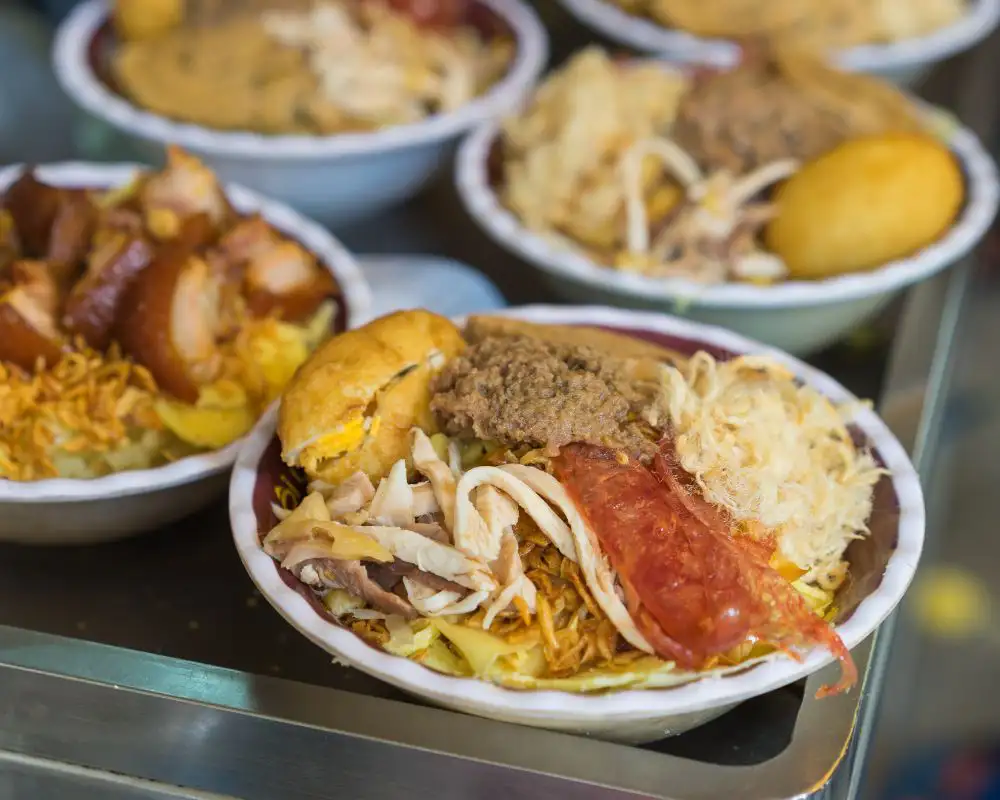
11. Gỏi cuốn (Vietnamese spring rolls)
Spring rolls originated from the South of Vietnam. The filling of spring rolls can be fish, meat, vegetables, but traditional spring rolls are usually made from boiled pork, boiled shrimp, fresh vermicelli, thinly sliced cucumbers, long chives, sliced onions, carrots, pickled in vinegar or minced green mango, herbs, salad… wrapped with rice paper. The accompanying dipping sauce can be sweet and sour fish sauce or black soy sauce with chili and pounded roasted peanuts.
12. Bún Thịt Nướng (Grilled Pork and Rice Vermicelli)
Vermicelli with grilled pork is one of Best Vietnamese street food in Ho Chi Minh that originated in the South of Vietnam, later spread widely in many parts of the country. You can have this dish for breakfast, lunch or dinner.
The way you do it will be quite simple, first cut the meat into a large bowl and season with spices such as lemongrass, garlic, pepper, fish sauce, salt, … then arrange the meat on a griddle, grill on charcoal, when grilling, you must turn the meat evenly. Let the meat cook evenly.
After grilling the meat, we will arrange raw vegetables in a bowl, add some vermicelli, and finally serve with sweet and sour fish sauce. You can choose to serve with grilled pork vermicelli with spring rolls.
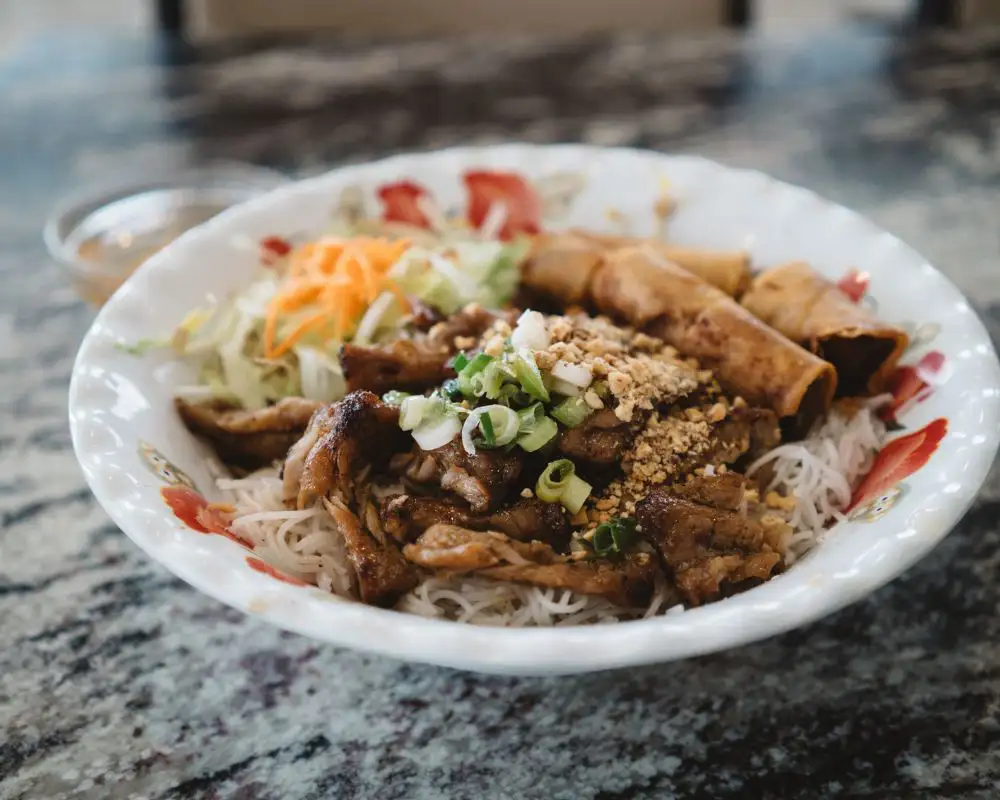
13. Bánh xèo (Pancake Vietnam)
Banh Xeo is often said to originate from the central region of our country and Vietnamese Street Food in Ho Chi Minh. In the Tay Son period, this dish was even so popular that it was used as a substitute for rice on the 2nd and 16th day of the lunar calendar every month.
In Binh Dinh, Quang Ngai or Quang Nam provinces, Banh Xeo is medium sized and wrapped in rice paper. Going south to Khanh Hoa, Ninh Thuan and Binh Thuan provinces, people use seafood as a filling instead of pork and bean sprouts, with fish sauce mixed with chili and roasted peanut sauce. The pancakes here are smaller in size and are sometimes rolled with raw vegetables.
Central pancakes are often served with sour star fruit, acrid bananas and a variety of herbs. Meanwhile, in the South, you will see people mixing coconut milk into the dough mixing stage, then adding mushrooms or lotus roots to make the filling.
Each pancake maker has their own recipe, combining the basic ingredients of fish sauce, lemon and chili with a variety of other spices, creating a variety of flavors for the dish.
The further you go along the country to the south, the larger the size of the pancake will be. In Cantho, Bien Hoa and Saigon, we see huge pancakes with fillings consisting of green beans, pork, shrimp, and bean sprouts, accompanied by a plate of fresh vegetables and herbs.
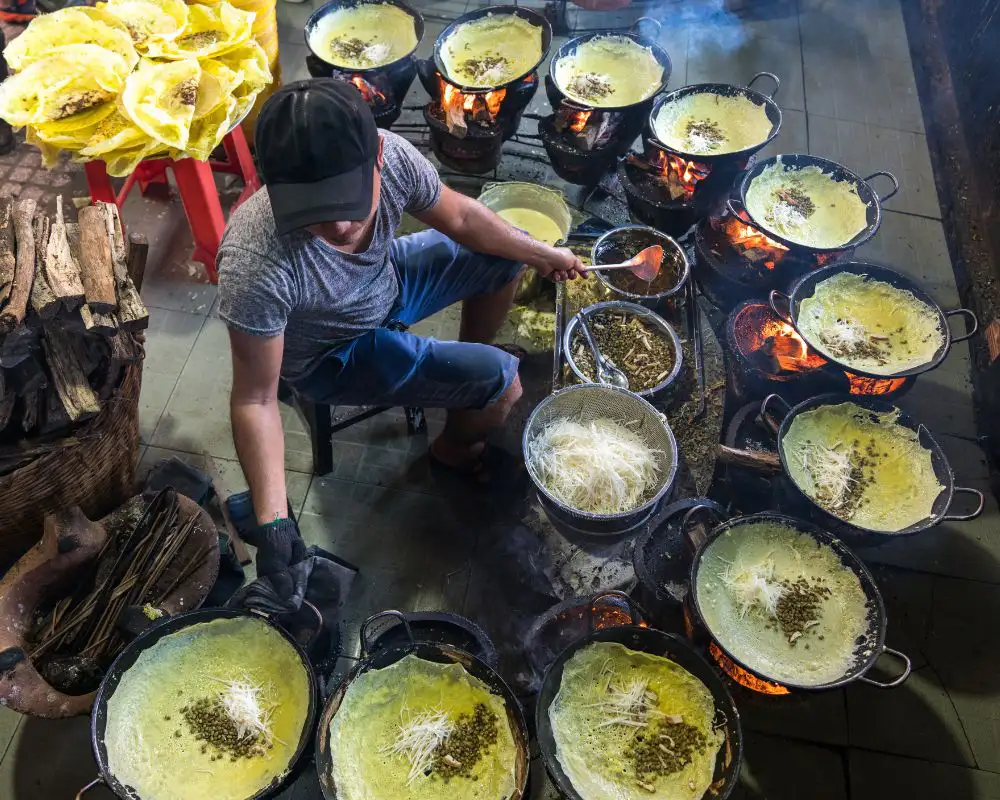
14. Ốc
When you’re in Ho Chi Minh City, you’ll often receive invitations from Vietnamese locals to “an oc,” which literally means “eat snails.” However, don’t be misled by the name; it simply refers to enjoying various types of seafood. These delectable dishes often include seafood delicacies.
At “Oc” restaurants, you’ll find an extensive array of cooking styles for seafood, such as grilling, stir-frying, steaming, boiling, and more. The seafood served in HCMC is sourced daily from the nearby seas, ensuring its freshness is always guaranteed.
To truly relish the flavors of these seafood delights, it’s best to accompany a Vietnamese friend who knows the finest selection of seafood and the ideal way to prepare each dish. They’ll be your guide to savoring the most exquisite seafood dishes that Ho Chi Minh City has to offer.
15. Lẩu Bò (Vietnamese beef hotpot)
Hot pot is a dish originating from China. Ho Chi Minh City offers a delightful variety of options, but the beef hot pot undeniably stands out as the crowd favorite. While the broth is also crafted from beef and beef bones, the distinctive flavor of beef hot pot sets it apart from Pho and Bun bo.
Typically, a beef hot pot comprises succulent beef brisket, flavorful beef bones, and hearty oxtail, accompanied by delectable taro, egg noodles, and abundant fresh vegetables. However, brace yourself for a surprising addition to the hot pot!
Read more: Top Best Chinese Restaurants in Ho Chi Minh
16. Bún Đậu Mắm Tôm (Rice vermicelli with fried tofu and shrimp paste sauce)
Bun Dau Mam Tom, a beloved traditional dish from Northern Vietnam, has also found its popularity among Ho Chi Minh City locals.
This delightful dish features rice vermicelli compressed into bite-sized pieces, served on a tray alongside crispy fried tofu, cha com (a unique Vietnamese ham blended with green rice flakes), rolled pork, and Vietnamese sausages. The show’s real star is the shrimp paste, a sauce known for its strong aroma but equally irresistible taste.
To enjoy this delicacy, dip all the accompanying ingredients into the shrimp paste, but if the scent proves too potent, fear not! You can balance it by adding a dash of lime, sugar, and chili, whisking it together for a perfect and harmonious blend of flavors.
17. Bún Riêu (Vietnamese crab soup with rice vermicelli)
Bún riêu originated from the North, turned into a popular breakfast food by Hanoians. The ingredients for a bowl of Bún riêu are indispensable for fresh vermicelli noodles, field crabs, tomatoes, vinegar, shrimp paste, onions.
Bun rieu stands out as a unique and distinct Vietnamese dish, setting itself apart from others in a delightful way. The broth of this dish is crafted from rice field crabs, which gives it a special flavor.
With the addition of tomatoes, the broth becomes incredibly delicious and acquires a visually appealing reddish hue.
A tempting bowl of Bun rieu typically consists of delectable meatloaves made from a blend of crab and minced pork, luscious tomatoes, crispy fried tofu, and succulent pork slices. What’s truly remarkable about this dish is its versatility – Vietnamese relish Bun rieu anytime, whether for breakfast, lunch, or dinner.
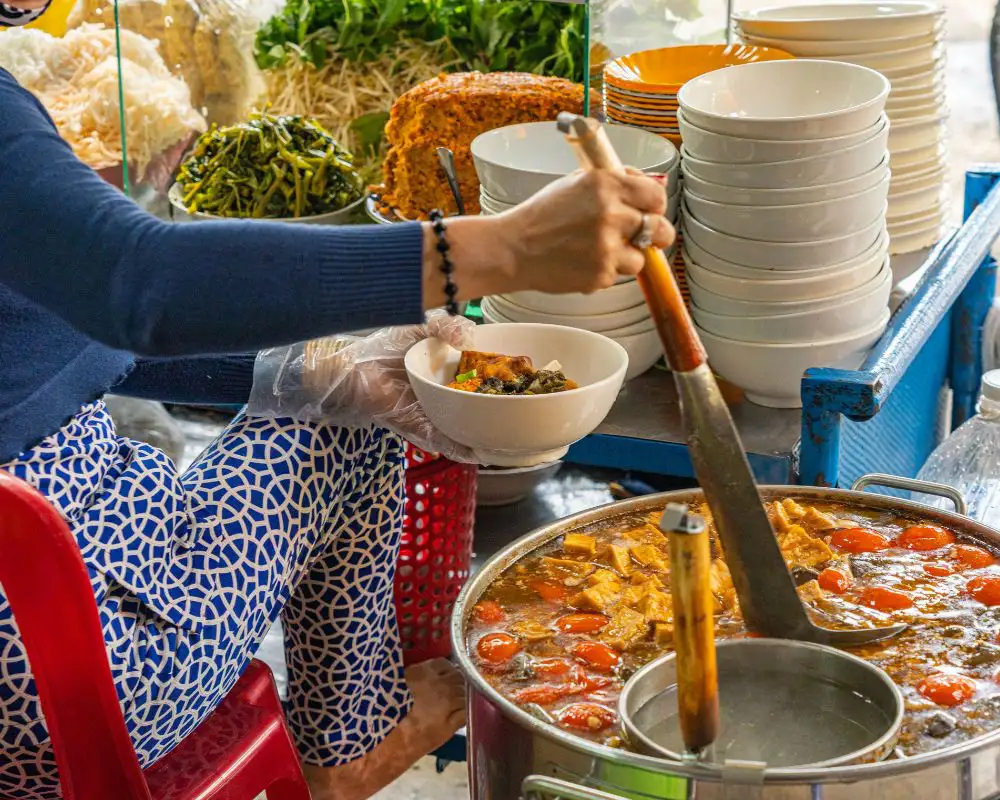
18. Bún Mắm (Vietnamese fermented fish paste soup with rice vermicelli)
“Mam,” also known as Vietnamese fermented fish paste, is a versatile ingredient widely used in various Vietnamese dishes, lending them a unique and distinctive taste.
Bun mam is among the dishes that feature this flavor-packed fermented fish paste. The addition of “mam” creates a vibrant and savory broth.
When served, you will see bun mam accompanied by succulent roasted pork, a delightful assortment of seafood, and freshwater fish, all harmoniously combined with fresh vegetables and edible flowers sourced from the enchanting Mekong Delta.
19. Chè (Vietnamese traditional sweet dessert)
Che is the best Vietnamese local food in Ho Chi Minh when discussing desserts. Che’s delightful combination of beans, sweet potatoes, and creamy coconut milk is divine.
If you’re in Ho Chi Minh City and seeking a refreshing cold treat, then Sam Bo Luong is the answer! Originating from Chinese cuisine, this special Che is an absolute gem.
Imagine a delightful blend of seaweed, jujubes, longan, jelly, and lotus root, all served chilled with ice, creating a burst of refreshing flavors. Sam Bo Luong is a true delight, perfect for cooling off on those warm HCMC days, leaving you feeling refreshed and satisfied.
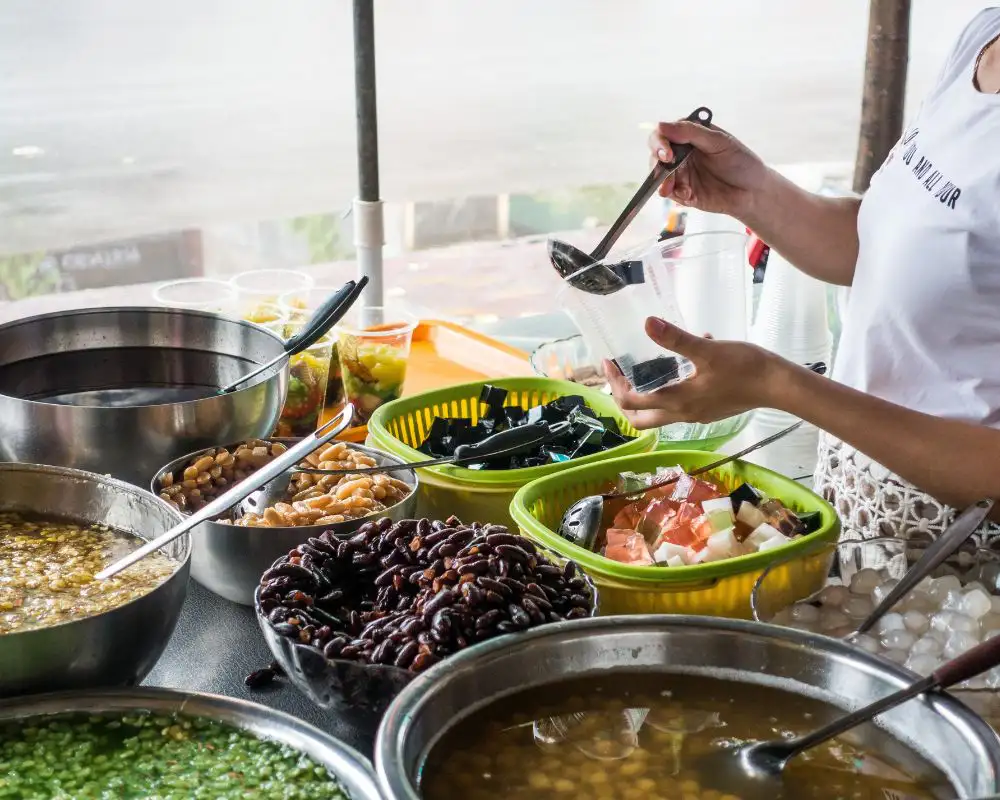
20. Bánh Tráng Nướng (Grilled Girdle Cake)
Grilled rice paper is a snack that originated in Phan Rang (Ninh Thuan), then become Dalat best dishes and became a favorite local food in Saigon.
Baked rice paper has many types, usually you will only know the cakes made simply from chicken eggs or quail eggs. The cake’s main ingredients are rice paper and chicken eggs, with a few more dried shrimp and green onions. Sometimes baked rice paper also has dried beef, pate, cheese, sausage, chicken or mayonnaise sauce…
The cake ingredients are quite simple, the processing is even simpler; First, put the rice paper on the griddle, beat the chicken eggs with dried shrimp, green onions and spread it evenly on the surface of the cake.
The combination of ingredients on a fragile base, on a burning charcoal stove, just a moment, a delicious, golden cake with a typical mountain town flavor has been released.
Read more: Top indian restaurant in Ho Chi Minh



